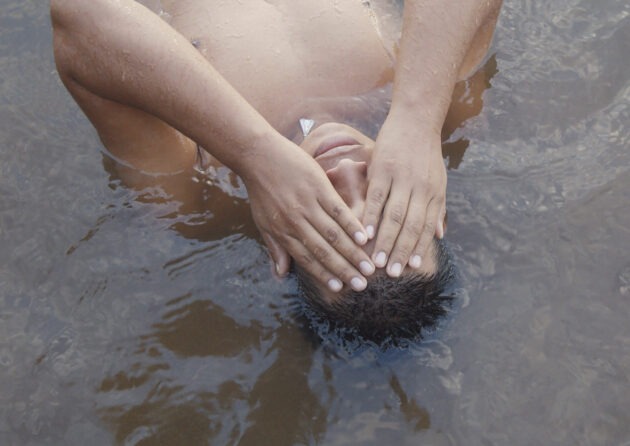Video artist graduated from the Ecole des Beaux-Arts in Bordeaux, Laure Subreville followed the Wayãpi and Teko communities in French Guyana for a month. She returns with a first documentary in which she draws a sensitive and moving portrait of groups of women and men, “elders” and young people, through their sounds and their music, and manages to tell a culture torn between spirituality traditions and utopias of modernity. At the L’Utopia cinema on Monday September 26 at 8:30 p.m., followed by a discussion with the director.
In the heart of the Amazon rainforest, flows the Oyapock River which separates Brazil from French Guiana. The sounds of nature invade the landscape through the water and through the forest. Carried by a motorized canoe, the camera lands on the banks of Camopi where the customary chief, Jean-Baptiste Breteau, tells the legend of an anaconda which had attacked the village. Welcome to the lands of the Wayãpi and Teko communities.
With Camopi One, 53-minute documentary, Laure Subreville signs an ethno-musical exploration with drawers. Left to “film only the music of the tule with the elders”, after scouting in January 2021, she discovered other facets of this distant French land with an indigenous youth seduced by the songs of metropolitan sirens.
Traditions and Claims
The tule (pronounced tulé) combines both music and dance, conviviality and spirituality, and is associated with festive rites of gifts, welcome, and purifying baths in the water of the river. In his village, Jean-Baptiste Breteau is the chief musician who selects the bamboos in the neighboring forest and manufactures the “clarinets”. He allows himself to be followed and filmed by Laure Subreville in the preparations for an intimate ceremony with the “elders”.
“The tule is a very important element because it is very representative of the Wayãpi culture, explains the director. There is a demand for the music of the tule and especially the Wayãpi language which tends to radiate beyond the borders of the village. More broadly, in our Western culture, we have been talking for several years about the Anthropocene and many other terms relating to the ecology of the world. The tule is a strong symbol of this transhumanist communion which is at the center of the vision of the Amerindian peoples. »
With the complicity of ethnomusicologist Jean-Michel Beaudet, Laure Subreville delicately interferes in this heritage and at the same time discovers a youth in thirst for recognition who asks her to film their rap, Haitian compass and reggae productions. The director then decided “that the music would be at the center of the film and would create a dialogue between the different generations”.
“The break with tule music is very clear with the younger generation in the village. There are several reasons for this. First of all, few elders practice and still know the songs of the tule. It is then difficult for young people to take up the torch. Young people are more individualistic and dream of a career on the Guiana coast first, then in mainland France. The relationship to the image was much more complicated for the musicians of tule, while the young people understood the potential visibility that a clip could bring. The clips were also a way to know the meaning of the lyrics of their songs and to highlight the problems of Aboriginal youth: unemployment, alcohol and drug abuse and above all suicide. »
The river as a common thread
This new generation gives its title to the film as the director explains:
” Camopi One comes from a leitmotif present in many recent songs. “Camopi Wan” means in Wayãpi “which comes from Camopi”. Adapted to globalized English – Wan becomes One –, it is therefore an identity slogan that claims to belong to a specific community, to a village and to a territory. »
Richardson, Siméon and other young people improvise freestyles on the village square or chant reggae on the banks of the river. With a smartphone and a Bluetooth speaker, they champion an entire Amerindian generation, shared between the traditional cultivation of giblets and the glorious dreams of a record company.
From these encounters and their diversities, the documentary offers a polyphony in which music and image converse between auto-tune effects and shell rattles. The destinies hang by a thread, that of the water of Oyapock, the river which “naturally connects all the characters of the film”, those who fish the koumarou with a net and those who take it easy.
Video artist and visual artist graduated from the School of Fine Arts in Bordeaux, Laure Subreville lives between Bordeaux and Lyon. After several short films related to music, Camopi One is his first documentary in partnership with the Ensemble Variances, the composer Thierry Pécou, the Amazonian Park and Massala production. It can be seen at the L’Utopia cinema this Monday, September 26 at 8:30 p.m., followed by a discussion with the director.
Camopi One, the enchanting documentary by Laure Subreville on a village in Guyana

